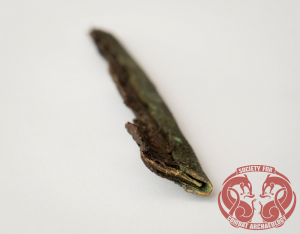Shields and Hide: The Use of Hide in Shield Constructions of the Iron Age and Viking Age

Iron Age shield rim with wooden shield board, layers of hide and bronze shield rim fitting (Photo: Jacob Nyborg Andreassen, SoCA)
While the southern Scandinavian region can boast of many relatively well-preserved shield finds – such as those stemming from the war booty sacrifices of the Iron Age – it is obvious that several important questions regarding their construction remain unanswered. This is particularly true with regards to the thin organic layers that seemingly once covered the shield boards but which have long since perished in the majority of archaeological finds. While it is generally accepted that these layers represent some constructional reinforcement (a facing or edge) of hide or gut, there remains to be undertaken a specialized study to determine the exact nature of these materials, especially with regards to tanning processes and animal species used. To illuminate these aspects of shield construction, therefore, this project seeks to undertake multiple microanalyses of samples collected from a range of well-preserved Scandinavian shield finds dating to the Iron Age and Viking Age, ranging from c. 350 BC to 1000 AD.
The study is an interdisciplinary project and collaborative effort between the Society for Combat Archaeology, the School of Conservation (Copenhagen) and Aarhus University. Project team members:
Rolf Fabricius Warming (Cand.mag., MA)
René Larsen (PhD, associate professor emeritus)
Dorte V. P. Sommer (Cand.scient.cons.)
Xenia Pauli Jensen (PhD)
Luise Ørsted Brandt (PhD)
